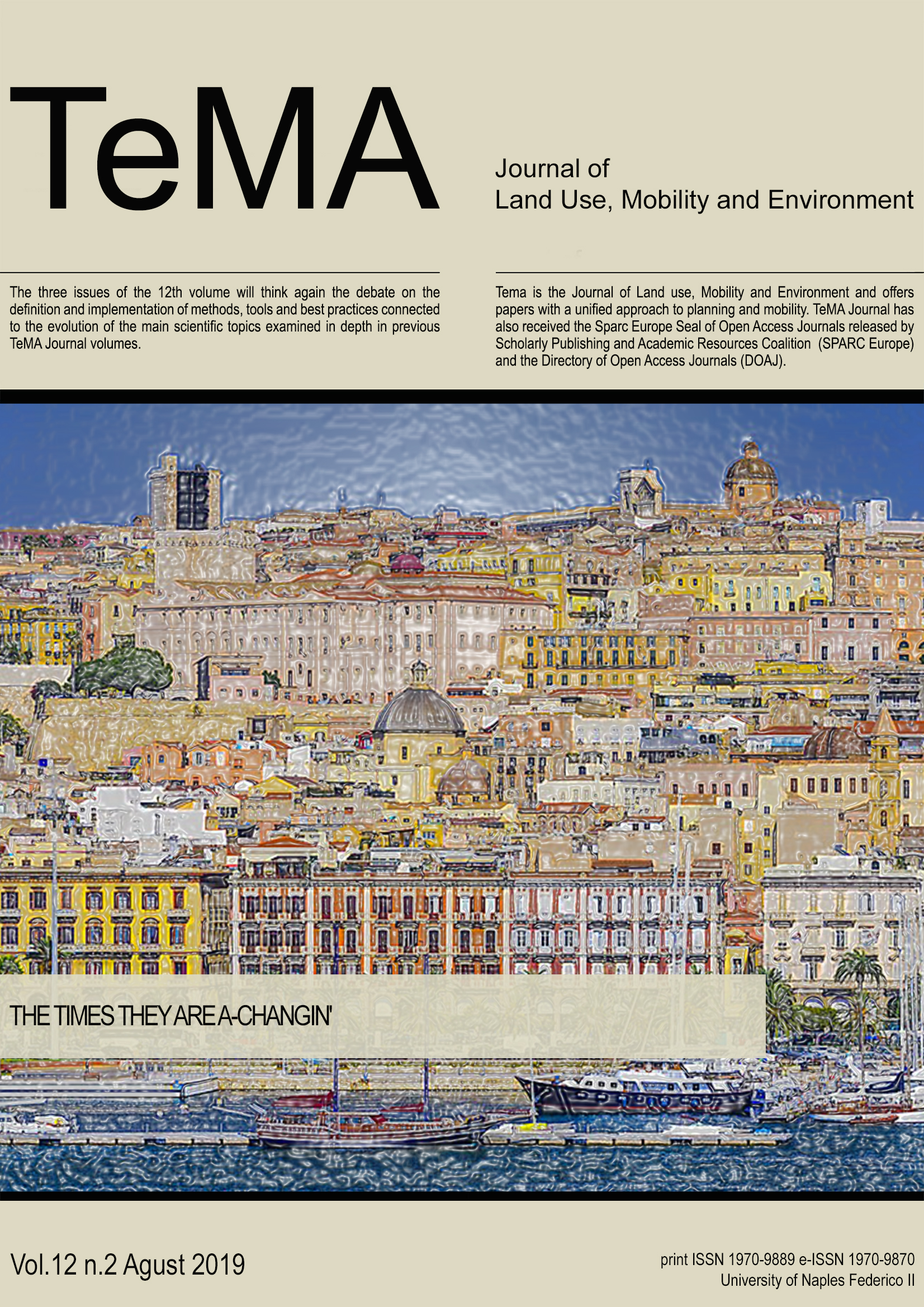Implementing the environmental dimension of the EU’s Urban Agenda 2014-2020
Abstract
This work illustrates the planning experience carried out by five municipalities of Western Sicily (Italy) in the the framework of the EU’s urban agenda 2014-2020. The planning process has led to the definition of a Strategy for Sustainable Urban Development (SSUD), whose general objectives are strengthening territorial cohesion and increasing accessibility to local resources. The SSUD action plan, being funded with around 70 millions euro, gives specific importance to sustainable mobility as a mean through which such objectives can be better achieved and reciprocally integrated.
After a brief description of the territory targeted by the SSUD (section 1), the paper focuses on the greenway concept within the broader debate on sustainable mobility. In section 3, a series of evidences are provided to identify the demand and potential for the development of sustainable mobility infrastructures in the five cities. In the fourth section, after describing the expceted results of the action plan in the field of sustainable transport, it is argued why in such specific territory a greenway is the best solution to increase accessibility to a broad range of resources and functions (natural sites, landscapes, cultural heritage, urban functions).
Downloads
References
Ahern, J. (1995). Greenways as a planning strategy. Landscape and Urban Planning, 33, 131-155. doi: http://dx.doi.org/10.1016/0169-2046(95)02039-V
Banister, D. (2008). The sustainable mobility paradigm. Transport Policy, 15(2), 73-80. doi: https://doi.org/10.1016/j.tranpol.2007.10.005
Benedict, M.A., & McMahon, E.T. (2006). Green Infrastructures. Linking Landscapes and Communities, Island Press: Washington, ISBN: 9781559635585
Bertolini, L. (2017). Planning the mobile metropolis. Transport for people, places and the planet, Palgrave: London, ISBN: 9780230308770
Bhat, C.R. (1995). A heteroschedastic extreme value model of intercity travel mode choice. Transportation Research, part B: Methodological, 29 (6), 471-483. doi: https://doi.org/10.1016/0191-2615(95)00015-6
Bierlaire, M. (2002). The total demand scale: a new measure of quality for static and dynamic origin-destination trip tables. Transportation Research, part B: Methodological, 36, 837-850. doi: https://doi.org/10.1016/S0191- 2615(01)00036-4
Bonavero, P., Dematteis, G., & Sforzi, F. (Eds.) (1999). The Italian urban system. Towards European integration. Ashgate: Aldershot, ISBN: 9781859722862
Buehler, R., & Pucher J. (2012). Cycling to work in 90 large American cities: New evidence on the role of bike paths and lanes. Transportation, 39, 409-432. doi: https://doi.org/10.1007/s11116-011-9355-8
Cascetta, E., Inaudi, & D., Marquis, G. (1993). Dynamic estimators of origin-destination matrices using traffic data. Transportation Science, 27, 363-373. doi: https://doi.org/10.1287/trsc.27.4.363
Chon, J., & Shafer, C.S. (2009). Aesthetic responses to urban greenway trail environments. Landscape Research, 34(1), 83-104. doi: https://doi.org/10.1080/01426390802591429
ESPON (2014). TOWN. Small and medium sized towns in their functional territorial context. Applied Research 2013/1/23, Final Report, Luxembourg.
Fabos, J. (1995). Introduction and overview: the greenway movement, uses and potentials of greenways. Landscape and Urban Planning, 33, 1-13. doi: https://doi.org/10.1016/0169-2046(95)02035-R
Forman, R.T.T., Sperling, D., Bissonette, J.A., Clevenger, A.P., Cutshall, C.D., Dale, V.H., Fahrig, L., France, R.L., Goldman, C.R., Heanue, K., Jones, J., Swanson, F., Turrentine, T., & Winter, T.C. (2003). Road ecology. Science and Solutions, Island Press: Washington, ISBN: 9781559639323
Gill, S., Handley, J., Ennos, R., & Pauleit, S. (2007). Adapting Cities for Climate Change: the Role of the Green Infrastructure. Built Environment, 33, 115-133. doi: https://doi.org/10.2148/benv.33.1.115
Gobster, P.H. (1995). Perception and use of a metropolitan greenway system for recreation. Landscape and Urban Planning, 33(1), 401-413. doi: https://doi.org/10.1016/0169-2046(94)02031-A
Grieco, M., & Urry, J. (2012). Mobilities: new perspectives on transport and society, Ashgate: Farnham, ISBN: 9781409411505
Hankey, S. et al. (2012). Estimating use of non-motorized infrastructure: Models of bicycle and pedestrian traffic in Minneapolis. Landscape and Urban Planning, 107(3), 307-316. doi: https://doi.org/10.1016/j.landurbplan.2012.06.005
Hickman, R., Hall, P., & Banister, D. (2013). Planning more for sustainable mobility. Journal of Transport Geography, 33, 210-219. doi: https://doi.org/10.1016/j.jtrangeo.2013.07.004
Hristova, S., Dragićević Šešić, M., Duxbury, N. (Eds.) (2015). Culture and Sustainability in European Cities: Imagining Europolis, Routledge: London-New York, ISBN: 9781138778412
Kazmierczak, A.E., & James, P. (2007). The role of urban green spaces in improving social inclusion. The International Postgraduate Research Conference in the Built and Human Environment, University of Salford: Greater Manchester, ISBN: 9781905732227
Lovell, S.T., & Taylor, J.R. (2013). Supplying urban ecosystem services through multifunctional green infrastructure in the United States. Landscape Ecology, 28, 1447-1463. doi: https://doi.org/10.1007/s10980-013-9912-y
Servillo, L., Atkinson, R., & Hamdouch, A. (2017). Small and medium-sized towns In Europe: conceptual, methodological and policy issues. Tijdschrift voor Economische en Sociale Geografie, 108(4), 365-379. doi: https://doi.org/10.1111/tesg.12252
Shafer, C.S., Lee, B.K., & Turner, S. (2000). A tale of three greenway trails: user perceptions related to quality of life. Landscape and Urban Planning, 49(3), 163-178. doi: https://doi.org/10.1016/S0169-2046(00)00057-8
Socco, C., Cavaliere, A., & Guarini, S. (2007). L’infrastruttura verde urbana, Osservatorio Città Sostenibili, Dipartimento Interateneo Territorio - Politecnico e Università di Torino, Working Paper, 11
Steiner, F.R. (2010). The Living Landscape: an Ecological Approach to Landscape Planning, Island Press: Washington, ISBN: 978-0070793989
Wong, K.I., Wong, S.C., Tong, C.0., Lam, W.H.K., Lo, H.K., Lo, H.P., & Yang, H. (2010). Estimation of Origin-Destination Matrices for a multimodal public transit network. Journal of Advanced Transportation, 39(2), 139-168. doi: https://doi.org/10.1002/atr.5670390203
Copyright (c) 2019 TeMA - Journal of Land Use, Mobility and Environment

This work is licensed under a Creative Commons Attribution 4.0 International License.
Authors who publish in this journal agree to the following:
1. Authors retain the rights to their work and give in to the journal the right of first publication of the work simultaneously licensed under a Creative Commons License - Attribution that allows others to share the work indicating the authorship and the initial publication in this journal.
2. Authors can adhere to other agreements of non-exclusive license for the distribution of the published version of the work (ex. To deposit it in an institutional repository or to publish it in a monography), provided to indicate that the document was first published in this journal.
3. Authors can distribute their work online (ex. In institutional repositories or in their website) prior to and during the submission process, as it can lead to productive exchanges and it can increase the quotations of the published work (See The Effect of Open Access)

